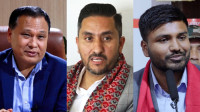National
Nepal seeks $1 billion from World Bank, others for Upper Arun
1,061 MW project will be the bank’s first investment in the country’s hydropower since it pulled out of Arun III in 1995.
Prithvi Man Shrestha
Nepal seeks an investment of around $1 billion from the World Bank and other international financial institutions to develop the 1,061MW Upper Arun Hydroelectric Project as the global lender tries to return to an Arun river project after a gap of 28 years.
On Saturday, Finance Minister Prakash Sharan Mahat discussed with bank officials their cooperation to develop the project at the 21st replenishment meeting of the International Development Association (IDA), a lending arm of the World Bank. The meeting in Morocco was aimed at supporting the world’s poorest countries.
After the global lender shelved its plan to invest in the Arun III Hydropower Project in 1995, it is returning to help develop another mega-power project on the same river.
“The World Bank is positive on providing as much as Rs130 billion, which is around $1 billion,” the finance ministry said in a statement. The two sides are scheduled to discuss increasing the World Bank’s concessional loan to develop the Upper Arun Project when a high-level Nepali delegation visits Washington next week, according to the ministry.
The World Bank, however, is not expected to provide all of $1 billion for the project with an estimated cost of $1.75 billion.
“The World Bank could inject as much as $550 million,” said Kul Man Ghising, managing director of Nepal Electricity Authority (NEA), the project developer. “The multilateral agency is expected to attract international financial institutions such as the European Investment Bank and others to inject more funds to take the total international financing up to $1 billion.”
Nepal is seeking more funding from international agencies than what it had sought earlier. In September last year, the NEA said that international agencies were expected to put as much as Rs97 billion into the project.
According to the power monopoly, the project will be implemented under a 70:30 debt-to-equity ratio. This means the project to be developed in the upper reaches of the Arun river at Bhotekhola Rural Municipality of Sankhuwasabha district will be funded with Rs150 billion in loans.
The World Bank will lead the international financiers while the Hydroelectricity Investment and Development Company Limited (HIDCL), a government entity, will lead the domestic financiers including Nepali banks and financial institutions, according to the NEA.
In September last year, the NEA, the Upper Arun Hydroelectric Company (the project implementing agency) and the HIDCL signed an investment agreement to generate resources for the project from domestic financers.
“We have targeted financial closure by May next year,” said Ghising. Financial closure means ensuring finance to develop the project.
This is the first time the World Bank is prepared to fund an NEA-led hydropower project. In 2014, the global lending agency approved $84.6 million to finance the Kabeli-A Hydroelectric Project developed by the private sector. In 2019, its private sector arm—the International Finance Corporation (IFC)—had led international creditors to invest $453 million in the 216MW Upper Trishuli 1 Hydropower Project. A South Korean consortium is developing this project.
The World Bank has been helping Nepal build transmission line projects.
Nepal faced long hours of power outages in 2008. Experts point to the bank’s exit from the Arun III project in August 1995 as the main reason behind several years of load-shedding in the country. The outages officially ended only after 10 years, in May 2018.
On August 1, 1995, then World Bank President James Wolfensohn cancelled the Arun III project “in agreement with the government of Nepal” citing concerns regarding Nepal’s management capability to meet the demands and long list of actions which the project of this size and complexity would involve; difficulty gaining support to implementing a number of measures including power tariff, and difficulty mobilising an additional $30-40 million cost overrun in case of project delays.
SJVN Limited, India’a state-owned company, is now developing the Arun III project.
The bank’s reentry in Nepal’s hydropower generation could attract more foreign investors as the country seeks to develop 30,000MW by 2035.
“The World Bank’s return to Nepal’s hydropower sector is a milestone,” said Ghising.




 15.69°C Kathmandu
15.69°C Kathmandu







%20(1).jpg&w=300&height=200)






